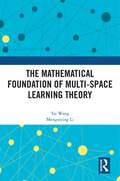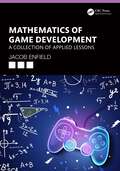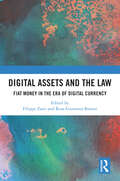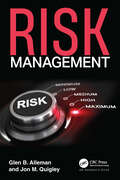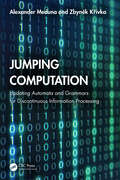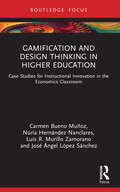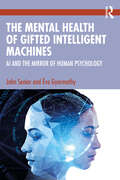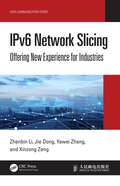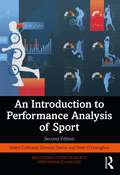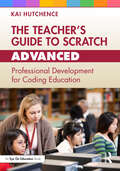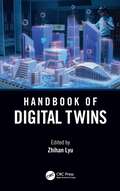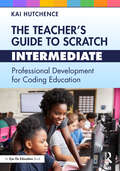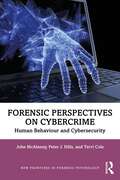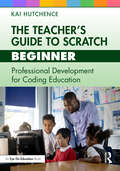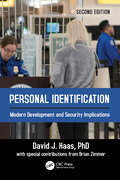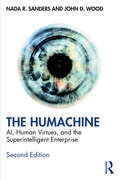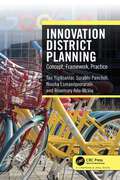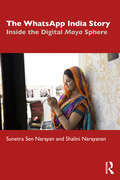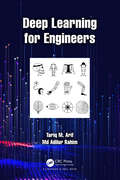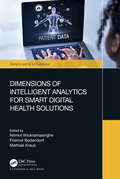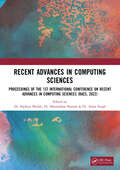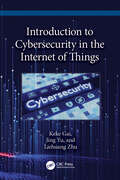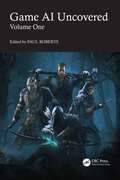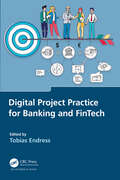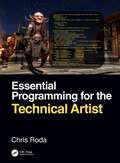- Table View
- List View
The Mathematical Foundation of Multi-Space Learning Theory
by Tai Wang Mengsiying LiThis book explores the measurement of learning effectiveness and the optimization of knowledge retention by modeling the learning process and building the mathematical foundation of multi-space learning theory.Multi-space learning is defined in this book as a micro-process of human learning that can take place in more than one space, with the goal of effective learning and knowledge retention. This book models the learning process as a temporal sequence of concept learning, drawing on established principles and empirical evidence. It also introduces the matroid to strengthen the mathematical foundation of multi-space learning theory and applies the theory to vocabulary and mathematics learning, respectively. The results show that, for vocabulary learning, the method can be used to estimate the effectiveness of a single learning strategy, to detect the mutual interference that might exist between learning strategies, and to predict the optimal combination of strategies. In mathematical learning, it was found that timing is crucial in both first learning and second learning in scheduling optimization to maximize the intersection effective interval.The title will be of interest to researchers and students in a wide range of areas, including educational technology, learning sciences, mathematical applications, and mathematical psychology.
Mathematics of Game Development: A Collection of Applied Lessons
by Jacob EnfieldThis introductory textbook introduces students to mathematical concepts and helps them to understand how they apply to the field of game development. This book covers the mathematical concepts commonly used in game development while providing opportunities to apply these concepts in the industry-standard Unity game engine.Most chapters cover mathematical concepts commonly used in game development, a downloadable game project that will provide a context to apply the math concepts learned, exercises for readers to practice the math concepts covered, and challenges for readers to further practice applying those concepts.This book will be ideal for any game development student looking to gain a grounding in the most relevant mathematical concepts to support their trade. It will also be useful as a stepping stone to digesting more advanced mathematical concepts for game development.
Digital Assets and the Law: Fiat Money in the Era of Digital Currency (Routledge-Giappichelli Studies in Law)
by Filippo Zatti and Rosa Giovanna BarresiThis book delves into the intricacies of digital assets. With the increasing reliance on crypto and the potential adoption of digital currencies by central banks, our monetary system is at a critical point. The importance of taking the next step has become even more stringent, as evidenced by this systematic scientific reconstruction.Divided into five concentric parts, the book starts with a historical, technical and financial introduction to digital assets. It then explores the changing role of central banking and monetary economics in the upcoming era. Finally, it focuses on the broad legal issues arising from the new digital landscape, not shying away from exploring forward-thinking solutions and policies for the future.With the contributions of prominent international experts in the field, this collection supplies a transdisciplinary analysis based on the belief that complex phenomena can only be handled by complex solutions. This groundbreaking work aims to be more than just an academic treatise; it is a must-read for students, scholars, financial professionals, and all those who want to understand the emerging digital currency reality that many have yet to fully recognise.
Risk Management
by Glen B. Alleman Jon M. QuigleyProject success is an elusive goal in every business or technical domain. Project failure usually results from unhandled risks to the technical, cost, and schedule aspects of the project. There are four primary root causes of project failure. Unrealistic performance expectation, with missing Measures of Effectiveness Unrealistic cost and schedule estimates based on inadequate risk adjusted growth models Inadequate assessment of risk and unmitigated exposure to these risks without proper handling strategies Unanticipated technical issues with alternative plans and solutions to maintain the effectiveness of the project processes and its deliverables Risk Management provides a comprehensive overview of the people, principles, processes, and practices as the fundamental base upon which an effective risk management system resides. However, this does not guarantee effective risk management and successful projects and businesses. The first half of the book describes risk management processes, as well as a delineation between risk and hazards and how these are connected. The second half of the book provides industry examples of the approach to risk management in specific context and with specific approaches and artifacts where applicable.The book focuses on risks created by uncertainty, their identification, and the corrective and preventive actions needed to address these risks to increase the probability of project success. The book’s goal is to provide a context-driven framework, developing a foundation for a rational approach to risk management that makes adaptation to circumstances as easy as possible.
Jumping Computation: Updating Automata and Grammars for Discontinuous Information Processing
by Alexander Meduna Zbyněk KřivkaJumping Computation: Updating Automata and Grammars for Discontinuous Information Processing is primarily a theoretically oriented treatment of jumping automata and grammars, covering all essential theoretical topics concerning them, including their power, properties, and transformations. From a practical viewpoint, it describes various concepts, methods, algorithms, techniques, case studies and applications based upon these automata and grammars. In today’s computerized world, the scientific development and study of computation, referred to as the theory of computation, plays a crucial role. One important branch, language theory, investigates how to define and study languages and their models, which formalize algorithms according to which their computation is executed. These language-defining models are classified into two basic categories: automata, which define languages by recognizing their words, and grammars, which generate them. Introduced many decades ago, these rules reflect classical sequential computation. However, today’s computational methods frequently process information in a fundamentally different way, frequently “jumping” over large portions of the information as a whole. This book adapts classical models to formalize and study this kind of computation properly. Simply put, during their language-defining process, these adapted versions, called jumping automata and grammars, jump across the words they work on. The book selects important models and summarizes key results about them in a compact and uniform way. It relates each model to a particular form of modern computation, such as sequential, semi-parallel and totally parallel computation, and explains how the model in question properly reflects and formalizes the corresponding form of computation, thus allowing us to obtain a systematized body of mathematically precise knowledge concerning the jumping computation. The book pays a special attention to power, closure properties, and transformations, and also describes many algorithms that modify jumping grammars and automata so they satisfy some prescribed properties without changing the defined language. The book will be of great interest to anyone researching the theory of computation across the fields of computer science, mathematics, engineering, logic and linguistics.
Gamification and Design Thinking in Higher Education: Case Studies for Instructional Innovation in the Economics Classroom (Routledge Research in Higher Education)
by Carmen Bueno Muñoz José Ángel López Sánchez Núria Hernández Nanclares Luis R. Murillo ZamoranoThis book analyzes the use of gamification and design thinking in higher education, examining how both techniques can be combined and used together to promote motivation, engagement, and participation among students. Using two in-depth examples, the authors show that the introduction of a gamified design in a design thinking activity can be a powerful tool to enhance the experiences of students in the teaching-learning process of a subject; motivate participants in a design thinking activity in the university environment; and enhance skills such as creativity, critical thinking and problem-solving, and collaboration, widely demanded in the labor market. Further, they examine how gamification and design thinking in the educational field can enable both the motivation and engagement of students and promote behavioral changes that materialize as a boost in learning outcomes and academic performance. Providing valuable recommendations and insights into the analysis, design and development, and implementation and evaluation of gamified design thinking activities to be carried out in higher education, as well as examining relevant ethical issues, the book will appeal to scholars, researchers, academic faculty, and educators working in the field of higher education, and with interests in educational psychology and theories of learning.
The Mental Health of Gifted Intelligent Machines: AI and the Mirror of Human Psychology
by John Senior Éva GyarmathyThe Mental Health of Gifted Intelligent Machines explores the increasingly sophisticated behaviours of developing AI and how we can ensure it will have emotional resilience, ethical strength and an ability to think in a new and enhanced way. Its primary aim is to change how we understand the world by investigating humanity as an intelligent being, examining and contrasting human and artificial intelligence. The book considers what we can learn from the likely mental health issues that will occur with increasingly sophisticated aspects of machine intelligence and how they will reflect the human condition. It asks questions about our identity in a deeply uncertain and disruptive ever-changing world; how we will improve and enhance our psychological intelligence to meet the increasing complications and demands of the future; and what we need to do, now, to be psychologically intelligent enough to live a full meaningful life in a new world evolving around us. The book argues that changes in our understanding of mental health, psychology and our view of intelligence will challenge huge aspects of our fundamental beliefs and assumptions and that it is essential we explore new arenas to further understand both our own human psychological issues and mental health as we develop gifted intelligent machines. It is a must read for all students, researchers and professionals involved with AI, gifted education, consciousness and mental health.
IPv6 Network Slicing: Offering New Experience for Industries (Data Communication Series)
by Jie Dong Zhenbin Li Yawei Zhang Xinzong ZengThis book is an essential guide to IPv6 network slicing. It covers both the fundamentals and cutting-edge technologies of IPv6 network slicing, and provides insights into future industry developments.IP network slicing is an architectural innovation that provides multiple dedicated logical networks on a shared physical network. It comprises a complete set of solutions designed to meet the differentiated service requirements of the 5G and cloud era. This book focuses on IP network slicing based on the data plane of IPv6, a second-generation network layer protocol standard designed to address many of the problems encountered with IPv4. The book explores the technical implementation of IPv6 network slicing by introducing its architecture, implementation solutions, resource partitioning technologies, data plane technologies, and control plane technologies. It also explains how to deploy IPv6 network slicing through slice controllers and provides deployment suggestions based on Huawei practices.It is a must-read for professional engineers involved in network planning, design, and technology support. Researchers and students in information and communication technology and communication system design will also find it useful.
An Introduction to Performance Analysis of Sport (Routledge Studies in Sports Performance Analysis)
by Peter O'Donoghue Adam Cullinane Gemma DaviesPerformance analysis has become an essential tool for coaches, athletes, sports organisations and academic researchers. Collecting and interpreting performance data enables coaches to improve their training programmes, athletes to make better tactical decisions, sports organisations to manage teams more effectively and researchers to develop a better understanding of sports performance. This fully revised new edition is an essential introduction to the fundamental principles of performance analysis of sport and how to develop and operate performance analysis systems.Containing worked examples from real sporting events as well as new content examining innovations in determining what to analyse, advances in feedback technology, performance profiles, principles for delivering feedback and telestration within video sequences, An Introduction to Performance Analysis of Sport reviews the different types of data and information that performance analysis can generate and explains how to test for reliability.This cutting-edge book presents a step-by-step guide to developing both manual and computerised analysis systems and writing up and presenting findings from performance analysis programmes. Representing the most up-to-date, concise and engaging introduction to sports performance analysis, this book is an ideal course text for all introductory performance analysis courses, as well as an invaluable primer for coaches and practitioners in sport.
The Teacher’s Guide to Scratch – Advanced: Professional Development for Coding Education
by Kai HutchenceThe Teacher’s Guide to Scratch – Advanced is a practical guide for educators preparing sophisticated coding lessons and assignments in their K–12 classrooms. The world’s largest and most active visual programming platform, Scratch helps today’s schools answer the growing call to realize important learning outcomes using coding and computer science. This book illustrates the expert-level potential of Scratch coding, details effective pedagogical strategies and learner collaborations, and offers actionable, accessible troubleshooting tips. Geared toward the advanced user, these four unique coding projects will provide the technical training that teachers need to master Scratch, feeling comfortable and confident in their skills as they unlock the program’s full potential for themselves and their students. Clear goals, a comprehensive glossary, and other features ensure the project’s enduring relevance as a reference work for computer science education in grade school. Thanks to Scratch’s cost-effective open-source license, suitability for blended and project-based learning, notable lack of privacy or security risks, and consistency in format even amid software and interface updates, this will be an enduring practitioner manual and professional development resource for years to come.
Handbook of Digital Twins
by Zhihan LyuOver the last two decades, Digital Twins (DTs) have become the intelligent representation of future development in industrial production and daily life. Consisting of over 50 chapters by more than 100 contributors, this comprehensive handbook explains the concept, architecture, design specification and application scenarios of DTs.As a virtual model of a process, product or service to pair the virtual and physical worlds, DTs allow data analysis and system monitoring by using simulations. The fast-growing technology has been widely studied and developed in recent years. Featured with centralization, integrity and dynamics, it is cost-effective to drive innovation and performance. Many fields saw the adaptation and implementation across industrial production, healthcare, smart city, transportation and logistics. World-famous enterprises such as Siemens, Tesla, ANSYS and General Electric have built smart factories and pioneered digital production, heading towards Industry 4.0.This book aims to provide an in-depth understanding and reference of DTs to technical personnel in the field, students and scholars of related majors, and general readers interested in intelligent industrial manufacturing.
The Teacher’s Guide to Scratch – Intermediate: Professional Development for Coding Education
by Kai HutchenceThe Teacher’s Guide to Scratch – Intermediate is a practical guide for educators preparing moderately complex coding lessons and assignments in their K-12 classrooms. The world’s largest and most active visual programming platform, Scratch helps today’s schools answer the growing call to realize important learning outcomes using coding and computer science. This book illustrates the increasingly intricate affordances of Scratch coding, details effective pedagogical strategies and learner collaborations, and offers actionable, accessible troubleshooting tips. Geared toward the intermediate user, these four unique coding projects will provide the technical training that teachers need to feel comfortable and confident in their skills and to help instill the same feeling of accomplishment in their students. Clear goals, a comprehensive glossary, and other features ensure the project’s enduring relevance as a reference work for computer science education in grade school. Thanks to Scratch’s cost-effective open-source license, suitability for blended and project-based learning, notable lack of privacy or security risks, and consistency in format even amid software and interface updates, this will be an enduring practitioner manual and professional development resource for years to come.
Forensic Perspectives on Cybercrime: Human Behaviour and Cybersecurity (New Frontiers in Forensic Psychology)
by Peter J. Hills Terri Cole John McAlaneyForensic Perspectives on Cybercrime is the first book to combine the disciplines of cyberpsychology and forensic psychology, helping to define this emergent area. It explores the psychological factors that influence the behaviour of all those involved in cybersecurity, drawing upon the research literatures in relevant areas including forensic, social, and cyberpsychology.Written by leading figures in the field, the book provides an introduction to the cybercrime ecosystem, before discussing the psychological manipulation of targets through social engineering techniques and highlighting the unique threats that this type of attack presents. The reasons why people become involved in hacking are explored, and the authors review research literature on risk factors of being a victim of cybercrime, along with the concept of resilience. Behaviour change and prevention strategies are also evaluated, as well as the role of emergent technologies such as artificial intelligence and what this may mean for the role of humans in cybersecurity. Case studies and real-world examples are woven throughout to illustrate key issues, opportunities, and challenges.This unique text is a must-read for students undertaking any degree that relates to behaviour and cybersecurity, including psychology, computing, law, and business management. It is also highly relevant to researchers, practitioners, and policymakers who work in cybersecurity and/or have an interest in empowering people to be safe online.
The Teacher’s Guide to Scratch – Beginner: Professional Development for Coding Education
by Kai HutchenceThe Teacher’s Guide to Scratch – Beginner is a practical guide for educators preparing beginners-level coding lessons and assignments in their K–12 classrooms. The world’s largest and most active visual programming platform, Scratch helps today’s schools answer the growing call to realize important learning outcomes using coding and computer science. This book illustrates the benefits and fundamental building blocks of Scratch coding, details effective pedagogical strategies and learner collaborations, and offers actionable, accessible troubleshooting tips. Geared toward the fledgling user, these four unique coding projects will provide the technical training that teachers need to feel comfortable and confident in their skills and to help instill the same feeling of accomplishment in their students. Clear goals, a comprehensive glossary, and other features ensure the project’s enduring relevance as a reference work for computer science education in grade school. Thanks to Scratch’s cost-effective open-source license, suitability for blended and project-based learning, notable lack of privacy or security risks, and consistency in format even amid software and interface updates, this will be an enduring practitioner manual and professional development resource for years to come.
Personal Identification: Modern Development and Security Implications
by David J. HaasPersonal Identification: Modern Development and Security Implications, Second Edition explains how personal identification – and REAL ID – became part of the American fabric along with their past century’s historical ID development. The development of the “trusted and secure” personal identification documents began with passports and has continued as social changes made IDs more essential. This book describes the convergence of technologies and hundreds of patents that produced our “trusted and secure” documents and IDs from our past right up through to today.Key factors, that created today’s need for public-issued mass ID, are addressed: Chronicles the effects of large and mobile populations beginning a century ago Chronicles the effects of “impersonal” electronic & computer communications at a distance, and not face-to-face The distribution of services and money by government agencies based on a person’s identity – including “age” and “group” criteria Describes recent national security and terrorism concerns that necessitates the need to know: “You are who you say you are.” Personal identification documents (IDs) and the societal need for “trusted” identification by the public is a relatively new social phenomenon. In 1900, most people did not need or have any IDs until passports, with a photograph of the individual, became mandatory when Great Britain entered World War I in 1914. In the United States, the State-issued driver’s license is probably the only trusted ID in one’s wallet today, but they became “trusted and secure” documents only recently with the requirement for REAL ID. With the first photo driver’s license issued by the State of Colorado in 1959, it took until 1984 for the last State (New York, 25 years later) to comply.As a direct result of 9/11, where terrorists used fake driver’s licenses to board planes, Congress passed the Real ID Act in 2005 to make all State-issued driver’s licenses more trusted, uniform, and tamper-resistant – what is now called the Enhanced Driver’s License with non-drivers being issued Enhanced Identification Cards. And with this, every US citizen can now possess a trusted and secure personal identification document.Personal Identification, Second Edition chronicles the path of personal identification measures – including the latest developments of Real ID. Scholars and professional security managers understand that stability, security, and safety necessitate these identity measures to ensure a safer America. The book explains the various stages and advances, providing readers with a unique study of this fascinating history of the relationship between identity and the means by which one validates and proves their own identity. The enactment of the REAL ID Act of 2005, with more secure and tamper-resistant documents for each citizen of the United States, is being instituted so that one can trust: “you are who you say you are.” The State-issued driver’s license is not a National ID Card – it is a Nationally Recognized ID for each citizen.
The Humachine: AI, Human Virtues, and the Superintelligent Enterprise
by Nada R. Sanders John D. WoodUpdated for a post-Covid world, the second edition of this groundbreaking book explains why becoming a Humachine enterprise is the only way forward for a company to maintain a competitive advantage in the age of artificial intelligence (AI).The first edition of The Humachine offered a foundation for a new form of enterprise, integrating AI technology and human resources to optimize the unique advantages possessed by each. Now, in the face of the ‘Great Resignation’ and ‘botsourcing’—where an activity previously done by humans is replaced by technology—thought leaders Sanders and Wood present a more positive and promising scenario, where an enterprise recognizes human resources as an asset class that possesses skills that cannot be replaced by automation. Enlightened business leaders will look to create synergy between technology and people, enabling the organization to maximize its capabilities by elevating the basis of decision making with closer-to-perfect information and rationality. This book provides a roadmap for how to do this and achieve collective intelligence at the enterprise level: superintelligence. More specifically, it answers these questions, and more. Why must an enterprise achieve superintelligence as a competitive advantage in the age of AI? How can any organization achieve superintelligence by following the 4-I model? What is the step-by-step process an enterprise should follow in becoming a Humachine? What strategies can be used by enterprise leaders to ‘futureproof’ the Humachine against uncertainty? All business leaders, executives, and managers at companies wanting to use AI and technology to survive and thrive in this new age, and students of analytics and decision-making, will value this thought-provoking and practical book, rich with case studies.
Innovation District Planning: Concept, Framework, Practice
by Tan Yigitcanlar Surabhi Pancholi Niusha Esmaeilpoorarabi Rosemary Adu-McVieThis book aims to fill the knowledge gap on how to plan, develop and manage innovation districts that are competitive in terms of both productivity and quality of living, justifying the massive investment put into place and at the same time doing both in a delicate and harmonious way.There is a need for smart urban land use that is wired with both hard infrastructures (e.g., telecommunication and transport) and soft infrastructures (e.g., diversity and tolerance). The reader learns this knowledge through conceptual expansions for key insights, frameworks for potential and performance assessment and best practices for global innovation districts. The authors begin innovation district planning with the role and effectiveness of planning a branding in the development of innovation districts. The next key topic of place making is recognised as a key strategy for supporting knowledge generation and innovation activities in the contemporary innovation districts. Another important topic is place quality where the reader learns to identify and classify indicators of place quality by studying global innovation districts best practices. The reader also expands their understanding on the classification of innovation districts based on their key characteristics through a methodological approach. The book concludes with district smartness studied through the socio-cultural role played by anchor universities in facilitating place making in innovation districts. Smart campuses, enabled by digital transformation opportunities in higher education, are seen as a miniature replica of smart cities and serve as living labs for smart technology.The book serves as a repository for scholars, researchers, postgraduate and undergraduate students as it communicates the complex innovation district phenomenon in an easy-to-digest form by providing both the big picture view and specifics of each component of that view.
The WhatsApp India Story: Inside the Digital Maya Sphere
by Sunetra Sen Narayan Shalini NarayananWhatsApp is used by over half a billion people in India today in all fields – in business, corporate and informal sectors, in government, for education and among friends, families and acquaintances. This book critically explores the social messaging app’s rapid expansion in India and its growing influence and looks at whether, as a form of horizontal communication, it poses a challenge to more traditional structures of communication. The book examines WhatsApp’s spread in the personal and professional lives of Indians and the myriad ways in which people in India are using the app in social and business interactions, including among people living with disabilities. Using case studies, interviews, surveys and in-depth research, it analyses key aspects of WhatsApp’s massive popularity and its impact on how people communicate. It also explores its impact on the psycho-social dynamics in India, including the dissemination of fake news and politically motivated content, and the consequent need for media regulation in the country. One of the first books to analyse the pervasiveness of WhatsApp and social media apps in different areas of Indian society, this book will be of interest to scholars and students of media studies, communication studies, digital media, cultural studies, cyberculture studies, sociology and social policy and media law.
Deep Learning for Engineers
by Tariq M. Arif Md Adilur RahimDeep Learning for Engineers introduces the fundamental principles of deep learning along with an explanation of the basic elements required for understanding and applying deep learning models. As a comprehensive guideline for applying deep learning models in practical settings, this book features an easy-to-understand coding structure using Python and PyTorch with an in-depth explanation of four typical deep learning case studies on image classification, object detection, semantic segmentation, and image captioning. The fundamentals of convolutional neural network (CNN) and recurrent neural network (RNN) architectures and their practical implementations in science and engineering are also discussed. This book includes exercise problems for all case studies focusing on various fine-tuning approaches in deep learning. Science and engineering students at both undergraduate and graduate levels, academic researchers, and industry professionals will find the contents useful.
Dimensions of Intelligent Analytics for Smart Digital Health Solutions (Analytics and AI for Healthcare)
by Nilmini Wickramasinghe Freimut Bodendorf Mathias KrausThis title demystifies artificial intelligence (AI) and analytics, upskilling individuals (healthcare professionals, hospital managers, consultants, researchers, students, and the population at large) around analytics and AI as it applies to healthcare. This book shows how the tools, techniques, technologies, and tactics around analytics and AI can be best leveraged and utilised to realise a healthcare value proposition of better quality, better access and high value for everyone every day, everywhere. The book presents a triumvirate approach including technical, business and medical aspects of data and analytics and by so doing takes a responsible approach to this key area. This work serves to introduce the critical issues in AI and analytics for healthcare to students, practitioners, and researchers.
Recent Advances in Computing Sciences: Proceedings of RACS 2022
by Amar Singh Sophiya Sheikh Manmohan SharmaThe 1st International Conference on Recent Advances in Computing Sciences (RACS-2022) organized by the School ofComputer Application, Lovely Professional University, Jalandhar, Punjab from 4th to 5th November, 2022.The conference focuses on discussing issues, exchanging ideas, and the most recent innovations towards the advancementof research in the field of Computing Sciences and Technology. All technical sessions were predominantlyrelated to Data Science, Artificial Intelligence, Remote Sensing, Image Processing, Computer Vision, Data Forensics,Cyber Security, Computational Sciences, Simulation & Modelling, Business Analytics, and Machine Learning.The main objective of this conference is to provide a common platform for academia and industry to discuss varioustechnological challenges and share cognitive thoughts. It provided a thought-provoking platform to discuss anddisseminate novel solutions for real-world problems in a dynamic and changing technological environment. The mainsuccess of RACS-2022 is to give an opportunity for the participants to enhance their knowledge of recent computingtechnologies.
Introduction to Cybersecurity in the Internet of Things
by Jing Yu Liehuang Zhu Keke GaiThis book addresses the security challenges facing the rapidly growing Internet of Things (IoT) industry, including the potential threats and risks arising from its complex architecture.The authors discuss the overall IoT architecture, covering networking, computing, and security threats and risks to hardware such as sensors, actuators, and portable devices, as well as infrastructure layers. They cover a range of technical concepts such as cryptography, distributed storage, and data transmission, and offer practical advice on implementing security solutions such as authentication and access control.By exploring the future of cybersecurity in the IoT industry, with insights into the importance of big data and the threats posed by data mining techniques, this book is an essential resource for anyone interested in, or working in, the rapidly evolving field of IoT security.
Game AI Uncovered: Volume One
by Paul RobertsGame AI Uncovered: Volume One kicks off a brand-new series of books that focus on the development of artificial intelligence in video games. This volume brings together the collected wisdom, ideas, tricks, and cutting-edge techniques from 20 of the top game AI professionals and researchers from around the world. The techniques discussed in these pages cover the underlying development of a wide array of published titles, including Hood: Outlaws and Legends, The Escapists 2, Sackboy: A Big Adventure, Call of Duty: Strike Team, GTI+ Club, Split/Second, Sonic All Stars Racing Transformed, Luna Abyss, Medal of Honor Heroes I & II, Age of Empires IV, Watch Dogs, Battlefield 2042, Plants vs. Zombies: Battle for Neighborville, Dead Space, and more. Contained within this volume are overviews and insight covering a host of different areas within game AI, including situational awareness, pathfinding, tethering, squad behaviours, coordination, auto-generating navigation link data, fluid movement, combining behaviour and animation systems, pedal control for cars, tactical positioning, level of detail, infinite axis utility systems, hierarchical state machines, bots for testing, reactive behaviour trees, and more. Beginners to the area of game AI, along with professional developers, will find a wealth of knowledge that will not only help in the development of your own games but will also spark ideas for new approaches. This volume includes chapters written by Andy Brown, Dr Allan Bruce, Richard Bull, Laurent Couvidou, Steven Dalton, Michele Ermacora, Jonas Gillberg, Dale Green, Johan Holthausen, Dr Aitor Santamaría Ibirika, Dr Nic Melder, Sarat Rallabandi, Bruno Rebaque, John Reynolds, Paul Roberts, David Rogers, Andrea Schiel, Huw Talliss, Dr Tommy Thompson, and David Wooldridge. .
Digital Project Practice for Banking and FinTech
by Tobias EndressNew technology and changes in the regulatory framework have had a significant impact; various new players have emerged, and new business models have evolved. API-based ecosystems have become the new normal and collaboration in the financial and banking industry has reached new levels. Digital Project Practice for Banking and FinTech focuses on technology changes in the financial industry and their implications for business practice.A combination of practical experience in the field as well as academic research, the book explores a wide range of topics in the multifaceted landscape of FinTech. It examines the industry’s various dimensions, implications, and potential based on academic research and practice. From project management in the digital era to the regulation and supervision of FinTech companies, the book delves into distinct aspects of this dynamic field, offering valuable insights and practical knowledge. It provides an in-depth overview of various unfolding developments and how to deal with and benefit from them.The book begins by exploring the unique challenges and opportunities project management presents in the digital era. It examines the evolving role of project management and provides strategies for effectively navigating the complexities of digital transformation initiatives. The book then covers such topics as: Financial Technology Canvas, a powerful tool for facilitating effective communication within fintech teams Process automation implementation in the financial sector and related benefits, challenges, and best practices to drive operational efficiency and enhance customer experiences Robotic process automation in financial institutions Cyptoeconomics and its potential implications for the diffusion of payment technologies The efficiency and risk factors associated with digital disruption in the banking sector. At its core, this book is about real-world practice in the digital banking industry. It is a source of different perspectives and diverse experiences from the global financial and banking industry..
Essential Programming for the Technical Artist
by Chris RodaThis book is based on a successful curriculum designed to elevate technical artists with no programming experience up to essential programming competency as quickly as possible. Instead of abstract, theoretical problems, the curriculum employs familiar applications encountered in real production environments to demonstrate each lesson.Written with artists in mind, this book introduces novice programmers to the advantageous world of Python programming with relevant and familiar examples. Any digital artists (not just technical artists) will find this book helpful in assisting with day-to-day production activities.Concentrating upon subjects relevant to the creation of computer graphic assets, this book introduces Python basics, functions, data types, object-oriented programming, exception handling, file processing, graphical user interface creation, PEP 8 standards, and regular expressions. Programming within the SideFX Houdini 3D animation software provides a familiar environment for artists to create and experiment with the covered Python topics.
